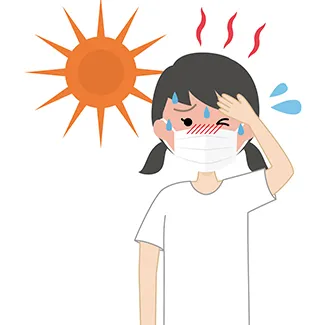July 17, 2020

This has been a hot summer so far in Denver, and in addition to taking precautions for heat when we work or play outside this year, we are all encouraged to monitor for symptoms of the novel coronavirus (COVID-19).
Heat Illness Symptoms versus COVID-19 Symptoms
The hot weather may make it difficult to tell the difference in symptoms of heat illness versus symptoms of COVID-19, as some symptoms of the novel coronavirus are similar to those of heat injuries.
Similar symptoms include:
- Fatigue
- Dizziness
- Fever
- Rashes
- Nausea
- Vomiting
- Confusion
Heat-related injuries may also have respiratory symptoms similar to COVID-19, such as shortness of breath. Heat-related injuries are most often related to working, exercising or playing in a hot environment. If you don’t have a specific history of being exposed to hot temperatures outdoors, a heat-related injury is unlikely.
Heat Rash and Sunburn Symptoms
Effects from the heat range from mild to severe. On the mild end of the spectrum is heat rash.
Heat rash symptoms include:
- A red rash
- Red bumps
- Occurring usually in warm areas of the body such as armpits or elbow creases
Sunburn is another consequence of sun and heat exposure. Denver is a mile closer to the sun than areas at sea level, making the sun stronger and the air thinner such that sunburn occurs quickly. Head up higher into the Rockies and the effects of the sun are magnified even more.
Models show that UV radiation increases by 10 percent for every 1,000 meters above sea level. This means the UV radiation from the sun at Breckenridge, sitting at 9,600 feet, is about 30 percent more than a city at sea level, such as New York.
Sunburns can become severe, cause blistering and be painful. Visitors to Colorado often do not consider the change in altitude when thinking about skin protection.
Heat Cramp and Heat Exhaustion Symptoms
Sunburns aren’t the only danger to watch out for. The heat can take a toll on body temperature and functioning, leading to heat cramps and heat exhaustion, particularly with activities held in the middle of the day, when the sun is strongest.
Heat cramp and heat exhaustion symptoms include:
- Painful muscle cramps
- Severe sweating
- Nausea and vomiting
- Fainting
Preventative treatments for heat cramps and heat exhaustion are:
- Maintaining good hydration
- Taking breaks to cool down
- Planning activities for early morning or evening
Heat Stroke Symptoms and Treatments
Heat stroke is the most severe effect of the heat and sun. During the summer, we see patients with this condition in the intensive care units. Usually, it’s unintentional. People love to enjoy the sun and warm weather and often lose track of time or underestimate their body’s condition to tolerate this environment.
Heat stroke symptoms include:
- A body temperature of 103 degrees Fahrenheit or greater
- Hot and dry skin
- Confusion
- Nausea or vomiting
- Fainting
Heat stroke can be life-threatening if not treated quickly and appropriately. These patients should be taken to the emergency room immediately for assessment and treatment.
Alcohol Use and the Sun
Alcohol can worsen the effects of the sun and heat. Alcohol itself can raise the body temperature and increase the risk of heat illness. It also leads to dehydration which worsens the symptoms of heat illness.
It’s not uncommon in the summer to see a patient who was drinking alcohol and then fell asleep in the sun leading to sunburn, hyperthermia and heat stroke.
Alcohol is also often combined with summer water activities, which is a dangerous combination. According to the Centers for Disease Control and Prevention (CDC), in adolescents and adults, alcohol use is involved in 70 percent of water-related deaths. Alcohol affects a person’s judgment, balance and coordination. Theses effects are increased by heat exposure and sun.
How to Stay Cool When It's Hot
How should you keep yourself, your family and even your pets safe from the heat? Use "smart sun- and heat-sense":
- Avoid being outside in the middle of the day when the sun is hottest and strongest
- If you are outside, take breaks to cool down regularly and stay hydrated
- Sports drinks can be helpful, but beverages with high levels of sugar and/or caffeine are also dehydrating, so be cautious
- Drinking water is always a good choice
- Wear hats and loose-fitting clothing
- Use sunscreen – including SPF lip balm – and re-apply regularly throughout the day
- Avoid alcohol, especially with water activities
- Monitor children and pets closely as they are more susceptible to the effects of the sun and heat
Should you or someone you know develop symptoms that may be due to the heat, move to a cool place, hydrate and, if needed, seek medical care.
What to Do If You Have Any Heat- or COVID-19-Related Symptoms
Should you have questions about onset of any new symptoms, contact your health care provider or seek immediate medical attention at an emergency department or urgent care if symptoms are severe. The CDC also provides resources and a self-check symptom site to help provide more information.
Remember that people with underlying health conditions like heart disease and diabetes, and those older than 65, are especially at risk for both heat-related illnesses and COVID-19.
While summer is a great time to enjoy our beautiful city, please take appropriate precautions to protect yourself and others from COVID-19 by wearing a face covering or mask, washing your hands, social distancing and staying home if you have concerning symptoms.
For more information on COVID-19 and Denver Health's response, visit DenverHealth.org/coronavirus.

